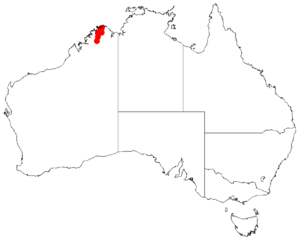Acacia dacrydioides facts for kids
Quick facts for kids Acacia dacrydioides |
|
|---|---|
| Scientific classification | |
| Genus: |
Acacia
|
| Species: |
dacrydioides
|
 |
|
| Occurrence data from AVH | |
Acacia dacrydioides is a unique shrub, a type of wattle, that grows only in the northwestern part of Australia. It belongs to the large Acacia plant family. This special plant was first described by botanist Mary Tindale in 1975.
What Does It Look Like?
This shrub usually grows as a loose, spreading plant. It can reach a height of about 1 to 3 meters (3 to 10 feet). Its branches are rounded and covered with fine hairs, appearing fawn to reddish-brown.
Like many Acacia species, this plant does not have true leaves. Instead, it has what are called phyllodes. These are flattened leaf stalks that act like leaves. The phyllodes of Acacia dacrydioides are always green and shaped like thin lines. They are about 0.6 to 1.3 centimeters (0.2 to 0.5 inches) long and very narrow, only 0.2 to 0.4 millimeters (0.008 to 0.016 inches) wide. They also have a few scattered hairs.
Flowers and Seed Pods
Acacia dacrydioides blooms between March and June. It produces bright yellow flowers that grow in spikes. These flower spikes are about 0.8 to 2.2 centimeters (0.3 to 0.9 inches) long.
After the flowers, the plant forms seed pods. These pods are smooth and look a bit like a string of beads. They have dark red to brown ridges. The pods are typically 6 to 8 centimeters (2.4 to 3.1 inches) long and about 5 millimeters (0.2 inches) wide. Inside, the seeds are arranged lengthwise along the pod.
Where Does It Grow?
This special Acacia is found only in the Kimberley region of Western Australia. It prefers to grow on rocky ridges. You can often find it in areas with sandstone and quartzite rocks.
Most of these plants live in the King Edward River district. This area is near the Kalumburu Mission. Here, Acacia dacrydioides is usually part of mixed woodland areas on ridges. It can also be found growing on river banks where the sand is deep.

